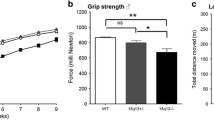Abstract
Congenic mouse strains made by transferring epilepsy predisposing alleles El1, El2, and El3 from the EL/Suz strain to the ABP/Le recipient were tested for seizure frequency following gentle rhythmic stimulation. Mice homozygous for El2, but not El1 or El3, experienced seizures much more frequently than ABP controls, while respective El1 homozygotes and El2 heterozygotes had only a modest increase over ABP, and El3 homozygotes showed no increase. Association between marker genotypes and seizure trequency in small intra-strain crosses showed that the phenotypic effects of El2 map to the selected interval, and that segregation of El2 accounts for virtually all genetic effects. However, in separating El2 from other EL susceptibility alleles, the seizure frequency phenotype was weaker and less heritable than in crosses between parental strains. These results confirm El2 as an important QTL and show that it has significant phenotypic effects in the absence of other EL-derived alleles, including El1. In addition, the present localization of El2 on Chr 2 suggests several potential candidate genes for El2, including the β subunit of phospholipase-C. The approach to dissecting complex traits by making congenic strains for individual QTL is discussed.
Similar content being viewed by others
References
Dietrich, W.F., Katz, H., Lincoln, S.E., Shin, H.-S., Friedman, J., Dracopoli, N., Lander, E.S. (1992). A genetic map of the mouse suitable for typing intraspecific crosses. Genetics 131, 423–447.
Flaherty, L. (1981) Congenic strains. In The Mouse in Biomedical Research, H.L. Foster, J.D. Small, J.G. Fox, eds. New York: Academic Press, Inc., pp. 215–222.
Flavin, H.J., Wieraszko, A., Seyfried, T.N. (1991). Enhanced aspartate release from hippocampal slices of epileptic (El) mice. J. Neurochem. 56:1007–1011.
Frankel, W.N., Taylor, B.A., Noebels, J.L., Lutz, C.M. (1994). Genetic epilepsy model derived from common inbred mouse strains. Genetics 138,481–489.
Frankel, W.N., Valenzuela, A., Lutz, C.M., Johnson, E.W., Dietrich, W.F., Coffin, J.M. (1995). New seizure frequency QTL and the complex genetics of epilepsy in EL mice. Mamm. Genome 6, 830–838.
Fueta, Y., Matsuoka, S., Mita, T. (1986). Crossbreeding analysis of the mouse epilepsy. Sangyo Ika Daigaku Zasshi, Suppl. 8, 417–424.
Hess, E.J., Jinnah, H.A., Kozak, C.A., Wilson, M.C. (1992). Spontaneous locomotor hyperactivity in a mouse mutant with a deletion including the Snap gene on chromosome 2. J. Neurosci. 12, 2865–2874.
Imaizumi, K., Ho, S., Kutsokake, G., Takizawa, T., Fuziwara, K., Tutikawa, K. (1959). Epilepsy-like anomaly of mice. Jikken Dobutsu [Exp. Anim. (Tokyo)] 8, 6–10.
Julius, D., Huang, K.N., Livelli, T.J., Axel, R., Jessell, T.M. (1990). The 5HT2 receptor defines a family of structurally distinct but functionally conserved serotonin receptors. Proc. Natl. Acad. Sci. USA 87, 928–932.
Kirschner, M.A., Copeland, N.G., Gilbert, D.J., Jenkins, N.A., Amara, S.G. (1994). Mouse excitatory amino acid transporter EAAT2: isolation, characterization, and proximity to neuroexcitability loci on mouse chromosome 2. Genomics 24,218–224.
Lander, E.S., Schork, N.J. (1994). Genetic dissection of complex traits. Science 265, 2037–2048.
Lander, E.S., Green, P., Abrahamson, J., Barlow, A., Daly, M.J., Lincoln, S.E., Newberg, L. (1987). MAPMAKER: an interactive computer package for constructing primary genetic linkage maps of experimental and natural populations. Genomics 1, 174–181.
Leiter, E.H. (1989). The genetics of diabetes susceptibility in mice. FASEB J. 3, 2231–2241.
Paigen, K. (1995). A miracle enough: the power of mice. Nature Med. 1, 215–220.
Paterson, A.H., Lander, E.S., Hewitt, J.D., Peterson, S., Lincoln, S.E., Tanksley, S.D. (1988). Resolution of quantitative traits into Mendelian factors using a complete linkage map of restriction fragment length polymorphisms. Nature 335, 721–726.
Prins, J.B., Todd, J.A., Rodrigues, N.R., Ghosh, S., Hogarth, P.M., Wicker, L.S., Gaffney, E., Podolin, P.L., Fischer, P.A., Sirotina, A., Peterson, L.B. (1993). Linkage on chromosome 3 of autoimmune diabetes and defective Fc receptor for IgG in NOD mice. Science 260, 695–698.
Rise, M.L., Frankel, W.N., Coffin, J.M., Seyfried, T.N. (1991). Genes for epilepsy mapped in the mouse. Science 253, 669–673.
Serreze, D.V., Prochazka, M., Reifsnyder, P.C., Bridgett, M.M., Leiter, E.H. (1994). Use of recombinant congenic and congenic strains of NOD mice to identify a new insulin-dependent diabetes resistance gene. J. Exp. Med. 180, 1553–1558.
Seyfried, T.N., Brigande, J.V., Flavin, H.J., Frankel, W.N., Rise, M.L., Wieraszko, A. (1992). Genetic and biochemical correlates of epilepsy in the EL mouse. Neurosciences 18, 9–20.
Siracusa, L.D., Abbot, C.M. (1994). Mouse Chromosome 2. Mamm. Genome 5(Suppl.).
Snell, G.D. (1948). Methods for the study of histocompatibility genes. J. Genet. 49, 87–108.
Suzuki, J., Nakamoto, Y. (1977a). El mouse: a model of sensory precipitating epilepsy. Excerpta Med. 427, 81–82.
Suzuki, J., Nakamoto, Y. (1977b). Seizure patterns and electroencephalograms of El mouse. Electroencephalogr. Clin. Neurophysiol. 43, 299–311.
Suzuki, J., Nakamoto, Y., Shinkawa, Y. (1982). Local cerebral glucose utilization in epileptic seizures of the mutant EL mouse. Brain Res. 226, 359–363.
Taylor, B.A., Rowe, L., Grieco, D.A. (1993). The MEV mouse linkage testing stock: mapping 30 novel proviral insertions and establishment of an improved stock. Genomics 16, 380–394.
Tecott, L.H., Sun, L.M., Akana, S.F., Strack, A.M., Lowenstein, D.H., Dallman, M.F., Julius, D. (1995). Eating disorder and epilepsy in mice lacking 5HT2C serotonin receptors. Nature 374, 542–546
Author information
Authors and Affiliations
Additional information
Center for Medical Genetics, Marshfield Medical Research Foundation, Marshfield, Wisconsin, 54449, USA
Rights and permissions
About this article
Cite this article
Frankel, W.N., Johnson, E.W. & Lutz, C.M. Congenic strains reveal effects of the epilepsy quantitative trait locus, El2, separate from other El loci. Mammalian Genome 6, 839–843 (1995). https://doi.org/10.1007/BF00292432
Received:
Accepted:
Issue Date:
DOI: https://doi.org/10.1007/BF00292432




